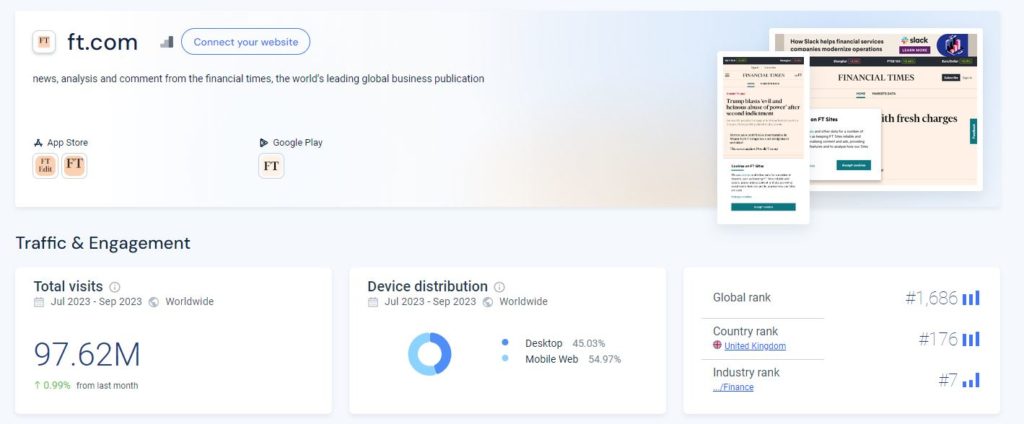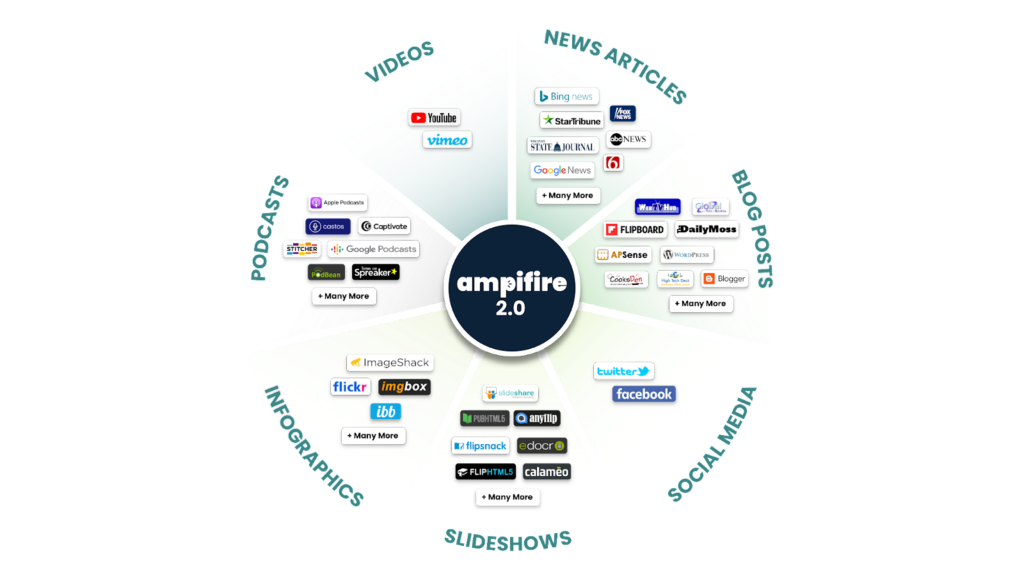- The Financial Times Press Release vs. Submitting a News Story Tip
- How to Contact The Financial Times to Feature Your Story
- How to Submit a Press Release & Publish Directly on The Financial Times
- How to Get a Backlink from The Financial Times
- Use AmpiFire to Publish to The Financial Times
- Frequently Asked Questions

The Financial Times Press Release vs. Submitting a News Story Tip
Most importantly, before diving deep into the nuances of press releases and news tips, it’s essential to understand the stature of The Financial Times (often abbreviated as FT). Founded in 1888, it has grown to become one of the world’s leading global business publications. Primarily, The Financial Times targets an audience deeply involved in the world of finance, business, and global markets. With a digital and print circulation surpassing a million and its content read by over 2.2 million individuals every day, The Financial Times doesn’t just inform; it influences.

Press Release vs. News Tip: The Key Differences
Now, let’s get into the crux of the matter.
- Press Release: This is a pre-written story, usually crafted by PR professionals or company representatives, intending to announce something noteworthy. Press releases sent directly to The Financial Times follow a particular format and style. They are designed to grab attention, be informative, and often highlight the significance of the news. If accepted, these releases can appear in relevant sections, either in print or online, making them a valuable tool for companies and individuals wanting to reach the FT’s elite audience.
- News Submission: On the other hand, news submissions are more like tips or suggestions for potential stories. They’re less structured than press releases and might be just the spark of an idea or a lead. Journalists and editors at FT can pick up these submissions and, if deemed newsworthy, develop them into full-fledged articles. Therefore, while a news submission might have a less direct route to publication, it can often result in more in-depth coverage.
Choosing between a press release and a news submission largely depends on your objectives and the nature of your news. While press releases provide more control over the narrative, news submissions offer the possibility of deeper, more explorative coverage. Besides that, understanding your target audience and tailoring your message to the readers of The Financial Times will enhance your chances of getting noticed.
How to Contact The Financial Times to Feature Your Story
When approaching a media giant like The Financial Times, Bloomberg, or YCharts, first impressions matter immensely. Think of it as preparing for an important job interview or pitching a million-dollar idea to investors. Therefore, a professional introduction isn’t just good to have; it’s a necessity. Below is a partial list of potential contacts at The Financial Times.
Contact Information for The Financial Times
- Sarah Andersen: Social Media and SEO Editor at Financial Times
- LinkedIn: Sarah Anderson
- Lydia Tomkiw: Senior Reporter at FundFire, a Financial Times Publication
- LinkedIn: Lydia Tomkiw
- Saffeya A.: Podcast Producer at Behind the Money, Financial Times
- LinkedIn: Saffeya Ahmed
- Jessica Smith: Podcast Editor and Producer at Financial Times
- LinkedIn: Jessica Smith
- Eva Thomas: Reporter at Ignites, a Financial Times publication
- LinkedIn: Eva Thomas
Additionally, you can reach out to The Financial Times directly through several avenues.
For general news tips, you can email the Financial Times at [email protected]. However, it’s important to note that the Financial Times does not accept hunches or press releases through these channels.
The Financial Times has a contact form on their website where you can submit information and send messages located here.
Do’s and Don’ts of Contacting The Financial Times
Because it’s essential to get it right, here’s a quick rundown:
Do’s:
- Be Clear and Concise: Time is of the essence, especially for busy journalists. Therefore, ensure your message is clear, concise, and doesn’t meander.
- Attach Relevant Documents: If you have press kits, reports, or any other relevant documentation, attach them. It shows you’re prepared.
- Follow Up, But Don’t Spam: If you haven’t received a response within a week, it’s acceptable to send a gentle follow-up. But remember, persistence is good; spamming is not.
Don’ts:
- Avoid Excessive Jargon: Even though it’s a financial news platform, your story needs to be understood by journalists who might not have a deep tech or finance background.
- Don’t Be Too Salesy: This isn’t a direct marketing pitch. Approach with a story or news angle, not a sales tactic.
- Don’t Send Mass Emails: Personalize your message to The Financial Times. Mass emails are easily spotted and often ignored.
In essence, when contacting The Financial Times, your professionalism, clarity, and authenticity will be your best allies.
How to Submit a Press Release & Publish Directly on The Financial Times
When it comes to establishing credibility and showcasing your brand’s achievements, getting your press release published in The Financial Times is like striking gold. Because this process can seem intricate, I’ve broken it down for you.
The Submission Process
- Craft a Compelling Press Release: This is your cornerstone. Ensure your press release is well-written, relevant, and resonates with The Financial Times‘ target audience. Remember, it’s not about volume, but value.
- Go to their ‘Submit a Press Release’ Page: Navigate to The Financial Times‘ official website. Under the ‘Contact Us’ section, you’ll find an option to ‘Submit a Press Release’. This is your gateway.
- Fill in the Required Details: This typically includes your name, email, company name, and the press release itself. Make sure all fields are accurately filled.
- Attach any Relevant Media: If you have images, videos, or infographics that can bolster your release, attach them. Visual aids can significantly enhance your story’s appeal.
- Submit and Wait: Once you’ve submitted, the waiting game begins. The editorial team will review your submission. If it fits the bill, they’ll reach out to you.
Bridging the Gap with AmpiFire
Navigating the press release landscape can be daunting. Therefore, using a platform like AmpiFire can simplify this task. It assists in crafting, distributing, and amplifying your press release, ensuring it reaches the right desks. Currently, AmpiFire does not submit directly to The Financial Times. Though not a one-stop solution, it’s certainly a helpful tool in your arsenal. To learn more about AmpiFire, check it out here!

In the grand scheme of things, publishing a press release in The Financial Times is more than just exposure; it’s about strategically positioning your brand in the global marketplace.
How to Get a Backlink from The Financial Times
For the uninitiated, a backlink is essentially a hyperlink from one website that points back to your own site. Think of it as a vote of confidence in your content from the linking website. In the realm of digital marketing, a backlink from a prestigious platform like The Financial Times is nothing short of a gold star for your site’s credibility and SEO prowess.
Steps to Secure a Backlink from The Financial Times:
- Craft Valuable Content: Most importantly, your content should be unique, well-researched, and provide value to The Financial Times‘ readership.
- Engage with Their Content: Familiarize yourself with the kind of articles they publish. Engage through insightful comments, or by sharing their articles on your social platforms.
- Forge Relationships with Their Writers: Start by following them on social media. Engage with their content, and gradually introduce your own when relevant.
- Guest Post: Offer to write a guest article for The Financial Times. Ensure the content is top-notch and subtly includes a link back to your site.
- Pitch a Story: If you have a newsworthy event or insight, pitch it. When they cover your story, they might just include that coveted backlink.
- Join Their Community and Forums: Being an active member can sometimes provide opportunities to include your site’s link in your profile or signature.
Remember, securing a backlink is just the first step. Ensuring your own content remains of high quality is essential to maintain the credibility that comes with such a noteworthy endorsement.

Use AmpiFire to Publish to The Financial Times
In the vast sea of content amplification platforms, AmpiFire stands out as a beacon for businesses and individuals aiming to gain traction in premier publications. AmpiFire, at its core, is an automated content amplification engine. It enables users to take a single piece of content and distribute it across various channels. Most importantly, its premium service offers a unique proposition: direct publishing to top-tier platforms.
Currently, AmpiFire doesn’t submit press release on your behalf to The Financial Times.
The Mechanics of AmpiFire’s Premium Service:
- Content Creation and Repurposing: The platform takes your primary content and repurposes it into multiple formats suitable for different platforms, be it blogs, videos, or podcasts.
- Amplified Distribution: Through its vast network, AmpiFire ensures your content reaches a wide array of platforms, maximizing visibility.
- Direct Publishing to The Financial Times: With the premium service, AmpiFire bridges the gap between your content and prestigious platforms, ensuring it is not just seen, but seen in the right places.
- Feedback and Analysis: After your content is disseminated, AmpiFire provides feedback on performance, helping you fine-tune your content strategy.
In conclusion, while there are multiple ways to amplify content, AmpiFire’s premium service ensures your content doesn’t just get amplified, but it resonates with the right audience, right where they are looking.
Your press release should be seen by as many people as possible.
Discover AmpiFire and get your press releases be seen on Google News, YouTube, SlideShare, Apple Podcasts and many more…
Click Here To Learn More
Take the leap! Dive into the world of content amplification and make your mark in esteemed platforms like The Financial Times. With all the tools and platforms available, isn’t it time your content got the spotlight it deserves?
Frequently Asked Questions
To get your content directly published on The Financial Times, it’s essential to submit a professionally crafted press release through their official channels or utilize platforms like AmpiFire’s premium service that bridges this gap for you for sites other than The Financial Times.
A press release for The Financial Times is a formal announcement or statement promoting something noteworthy, while a news story tip is a hint or a lead given to journalists for potential story ideas. Press releases are more structured and promotional, whereas news story tips are raw insights that can be transformed into full-blown stories.
Securing a backlink from The Financial Times enhances your site’s credibility because backlinks are endorsements from one website to another. Furthermore, considering The Financial Times‘ high authority in the financial realm, a backlink from them can significantly boost your SEO rankings.
Absolutely. When contacting The Financial Times, it’s crucial to professionally introduce oneself, ensuring the message is concise and relevant. Avoid sending generic pitches and always ensure your content aligns with their audience’s interests.
While AmpiFire is an efficient platform, especially with its premium service, to reach a vast audience, there are other platforms like PR Newswire and Business Wire. However, AmpiFire’s streamlined approach makes it stand out, providing a comprehensive service that takes care of content repurposing, amplification, and direct publishing. Currently, AmpiFire doesn’t submit press release on your behalf to The Financial Times.
Submitting a press release to The Financial Times can drastically elevate your business’s visibility. With its broad readership, your news will not only gain traction but also lend credibility to your brand, setting you apart in the industry.
While one might think of directly emailing content, it’s essential to understand that prestigious platforms like The Financial Times have specific submission processes in place. Following their prescribed protocol ensures a higher chance of your content getting noticed and published.
AmpiFire’s content repurposing involves transforming a single piece of primary content into various formats suitable for different platforms. This means your blog post could be repurposed into a podcast, video, or infographic, maximizing its reach across diverse channels.
Platforms like PRWeb and Outbrain offer content amplification services. While they have their unique features, AmpiFire’s all-inclusive approach, especially with its premium service offering direct publishing to top-tier platforms, sets it apart.
Choosing AmpiFire offers an edge with its automated content amplification engine, repurposing features, and its premium service’s direct publishing capability to many high-authority platforms. While other platforms provide amplification, AmpiFire’s comprehensive approach ensures your content resonates with the right audience.
